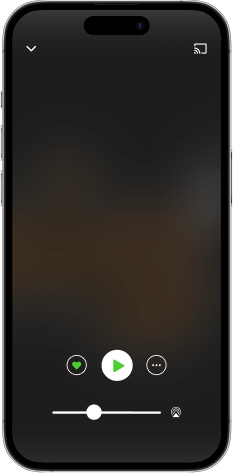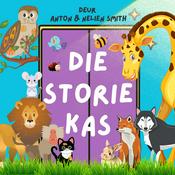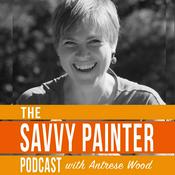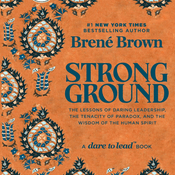135 episodes

Laverne Waddington, Backstrap Weaver (classic)
2025/12/27 | 51 mins.
Laverne Waddington discovered weaving by accident—bike accident, to be precise. Recuperating from a mountain biking crash in Utah, she discovered a book on Navajo weaving and was immediately intrigued. A local exhibit of Diné textiles enthralled her, and she set about learning to weave in the Navajo style. Returning to Patagonia, where she had been living, she built a simple loom and explored weaving on her own until it became clear that she would need to move north to satify her hunger for weaving knowledge, settling in Bolivia. Over the following decades, Laverne traveled in South and Central America, learning backstrap techniques from indigenous weavers. Her curiosity has led her to the Andean Highlands, Guatemala, and other regions to learn hand-manipulated and pick-up methods and patterns from skilled local weavers. Laverne loves to explore complex and intricate weaving styles, enjoying the way that each inch of warp and weft passes through her hands in a variety of pick-up techniques. Weaving on a backstrap loom, she sits inside each weaving project. Through videos, online classes, books, and ebooks, she teaches other weavers how to set up a backstrap loom for themselves and weave a variety of patterns. Teaching backstrap and pick-up techniques is as much a part of her practice as deepening her understanding of the weaving structures. In this episode, discover Laverne Waddington’s passions and processes. Links Laverne has maintained a blog and weaving journal on her website (https://backstrapweaving.wordpress.com/) since 2009. Laverne’s books (https://www.taprootvideo.com/instructorClasses.jsf?iid=3) are available from Taproot Video. Laverne offers a number of tutorials (https://backstrapweaving.wordpress.com/tutorials/) of techniques she practices as well as videos (https://backstrapweaving.wordpress.com/videos/) of a variety of weaving techniques and traditions. This episode is brought to you by: Treenway Silks is where weavers, spinners, knitters and stitchers find the silk they love. Select from the largest variety of silk spinning fibers, silk yarn, and silk threads & ribbons at TreenwaySilks.com (https://www.treenwaysilks.com/). You’ll discover a rainbow of colors, thoughtfully hand-dyed in Colorado. Love natural? Treenway's array of wild silks provide choices beyond white. If you love silk, you’ll love Treenway Silks, where superior quality and customer service are guaranteed.

Masey Kaplan & Jen Simonic, Loose Ends Project (classic)
2025/12/13 | 59 mins.
When Jen Simonic and Masey Kaplan’s friend lost her mother, she had the challenge of going through her mother’s things while grieving her loss. Among her posessions was something almost every crafter has at least one of: a work in progress. Jen and Masey had each finished projects for bereaved family members before, but neither of them could take on this one, a pair of crocheted blankets for two very tall sons. If the two of them were happy to finish a loved one’s unfinished craft project, they thought, other fiber artists would be willing to do it, too—fiber artists with a variety of craft skills. And there must be families of deceased crafters who weren’t lucky to know someone personally who could take on the task but would treasure having a finished item that their loved one began for them. So began Loose Ends (https://looseends.org/), an organization that Jen and Masey think of as matchmakers for heirs and finishers of uncompleted works, Loose Ends, which was established in May 2023 as a 501(c)3 nonprofit, set out to build a network that connects volunteer crafters with local families to complete projects that were left unfinished by death or disability. Hanging flyers near their homes, Jen and Masey quickly found finishers and projects in crochet, knitting, and quilting. Loose Ends currently seeks finishers in any textile handcraft and matches finishers with projects across the world. Projects under way include weaving, embroidery, and beading, as far afield as Alaska, Switzerland, and the Netherlands. Their informational flyer is now available in 12 languages. You may be surprised to learn that for about 2,000 projects in process, 25,000 volunteers have signed up as finishers—so crafters far outnumber craft projects at this time. But Loose Ends is always looking for more volunteer finishers, both to cover a variety of crafts and to match families with nearby finishers when possible. Any of us who love making things with our hands hate to think of our work in progress going to waste, languishing in boxes or (worse) winding up in the trash if we’re not able to finish them ourselves. By matching finishers and unfinished works, Loose Ends brings solace to families of deceased crafters and honors the work of their loved ones. Links: Loose Ends Project website (https://looseends.org/) Sign up as a finisher or request help with a loved one’s project on the web forms (https://app.looseendsproject.org/). Help families and finishers find Loose Ends by hanging flyers (https://looseends.org/flyers), which are available in several languages. Visit the website to make a donation (https://www.zeffy.com/en-US/donation-form/65186b43-546a-4077-a1d2-a7998a7ef83f). This episode is brought to you by: Treenway Silks is where weavers, spinners, knitters and stitchers find the silk they love. Select from the largest variety of silk spinning fibers, silk yarn, and silk threads & ribbons at TreenwaySilks.com (https://www.treenwaysilks.com/). You'll discover a rainbow of colors, thoughtfully hand-dyed in Colorado. Love natural? Treenway's array of wild silks provide choices beyond white. If you love silk, you'll love Treenway Silks, where superior quality and customer service are guaranteed. Learning how to weave but need the right shuttle? Hooked on knitting and in search of a lofty yarn? Yarn Barn of Kansas (https://www.yarnbarn-ks.com/) has been your partner in fiber since 1971. Whether you are around the corner from the Yarn Barn of Kansas, or around the country, they are truly your “local yarn store” with an experienced staff to answer all your fiber questions. Visit yarnbarn-ks.com (https://www.yarnbarn-ks.com/) to shop, learn, and explore. Brown Sheep Company is a four-generation family business bringing you high quality wool and natural fiber yarns. We spin and dye U.S.-grown wool into hundreds of vibrant colors at our mill in western Nebraska. Our mill has something to offer for every craft, from our well-known knitting and crochet yarns to wool roving for spinning and felting. We offer U.S-made needlepoint yarn as well as yarn on cones for weaving. Learn more about our company and products at BrownSheep.com (https://brownsheep.com/).

Amy Oxford, Oxford Punch Needle
2025/11/29 | 53 mins.
As a college student and weaver, Amy Oxford fell in love with the punch-needle method of rug hooking almost by accident, a surprising benefit from a babysitting gig. She followed her interest from doing piece work on existing designs to creating large commissioned rugs in her own business. In 1995, she started the Oxford Company to sell supplies and education for punch needle crafters worldwide. The basic techniques of punch needle are straightforward enough to teach in a few minutes, but the opportunities for creativity in line, texture, and color have kept Amy enthralled for 40 years. After completing several large commissioned works, she found herself with repetitive strain injuries in her hand and arm, and she began dreaming of a tool that would let her work pain-free. Partnering with a woodworker and inventor, she developed the Oxford Punch Needle, a groundbreaking wooden-handled tool with a curved grip that’s comfortable to push and pull through fabric. Along with manufacturing her own tool and selling hand-dyed yarn and supplies, Amy expanded her reach by teaching the technique, then opening a school that certifies instructors in her methods. Amy has also authored a number of books, most recently Intermediate & Advanced Punch Needle Rug Hooking: Techniques, Projects, and Inspirations with co-author Louise Kulp. Since selling her company in 2024, Amy has returned to punch needle just for the joy of it. “I can just make whatever I want and not have to tell anyone how I’ve done it,” she says. “I can just play, which is what my students have gotten to do. . . . And so I’m having a lot of fun now punching just for this sheer pleasure of it.” Links The Oxford Company website (https://amyoxford.com/) The Oxford Rug Hooking School (https://amyoxford.com/pages/oxford-rug-hooking-school) Oxford Punch Needle Handbook (https://cdn.shopify.com/s/files/1/1085/1826/files/Oxford_Punch_Needle_Handbook.pdf?v=1729862800) Amy Oxford’s books are published by Schiffer Craft. (https://www.schiffercraft.com/search?type=product&q=Amy+Oxford+product_type%3ACraft) This episode is brought to you by: Treenway Silks (https://www.treenwaysilks.com/index.php) is where weavers, spinners, knitters and stitchers find the silk they love. Select from the largest variety of silk spinning fibers, silk yarn, and silk threads & ribbons at TreenwaySilks.com (https://www.treenwaysilks.com/). You’ll discover a rainbow of colors, thoughtfully hand-dyed in Colorado. Love natural? Treenway's array of wild silks provide choices beyond white. If you love silk, you’ll love Treenway Silks, where superior quality and customer service are guaranteed. Follow the Threads (https://www.followthethreads.com/) to France on a 8-day tour of the rich traditions of French textiles. From tapestry of the Middle Ages to contemporary haute couture, our trips immerse you in the colors, forms, and techniques of half a millennium of textile fabrication and design. Guided visits are coupled with hands-on experiences in Paris, Versailles, and Calais. To learn more about this fiber adventure, visit followthethreads.com (https://www.followthethreads.com/). Have you heard of The Woolly Thistle? (https://thewoollythistle.com/) We’re a brick-and-click yarn shop specializing in non-superwash, woolly wool yarns from the UK and Europe. We have fast and free shipping and you can check us out at TheWoollyThistle.com (https://thewoollythistle.com/), two L’s in Woolly. (And let us do the international shipping and tariffs, so you don’t have to.)

Jordana Munk Martin, Tatter
2025/11/15 | 1h 1 mins.
At an unexpected juncture in her life, artist Jordana Munk Martin turned to the legacy of her grandmother’s trove of textile books. Edith Wyle founded the Craft and Folk Art Museum in Los Angeles in 1973, curating unconventional exhibits and instilling a love of art in her family. Her granddaughter found inspiration and comfort in the books, then opened the library for other artists to explore. That original collection is now the core of Tatter, a nonprofit organization named for soft, worn, well-used textiles. It includes the iconic Tatter Blue Library, an array of classes, a journal, and retail. “We’re really a conversation about cloth, housed in a cultural arts organization,” says Jordana. Tatter’s educational offerings began with classes in stitching, adding online classes and presentations when in-person learning became unavailable. One longstanding subject is the World Embroidery Series, which has offered detailed instruction in dozens of stitches and introduction to the rich cultural origins. The library invokes the cultural and spiritual connotations of the color blue. In an elegant dark blue–paneled space, the collection includes not only books but also drawers of buttons, a collection of swatches following the stitch patterns in Barbara Walker’s knitting treasuries, tools, and textiles. Tatter’s holdings now include treasured collections of 12 women: embroidered samplers, thimbles, darners, textiles, tools, and a luxurious assortment of fiber art books and periodicals. The Brooklyn Museum recently transferred 200 objects to Tatter, reflecting the organization’s deep and growing Brooklyn roots. Like Tatter, our conversation combines cultural inquiry with human connection. Links Read Jordana’s description of the Tatter Blue Library at “The Building of a Library.” (https://tatter.org/the-building-of-a-library/) Fina a list of Tatter’s online and in-person classes (https://tatter.org/events/). The third issue of Tatter’s journal, entitled Blue (https://tatter.org/issues/issue-3/), is available online. Read updates on the organization’s new home (https://tatter.org/230-ashland-place-capital-campaign/) in Brooklyn’s Cultural District. This episode is brought to you by: Treenway Silks (https://www.treenwaysilks.com/index.php) is where weavers, spinners, knitters and stitchers find the silk they love. Select from the largest variety of silk spinning fibers, silk yarn, and silk threads & ribbons at TreenwaySilks.com (https://www.treenwaysilks.com/). You’ll discover a rainbow of colors, thoughtfully hand-dyed in Colorado. Love natural? Treenway's array of wild silks provide choices beyond white. If you love silk, you’ll love Treenway Silks, where superior quality and customer service are guaranteed. Learning how to weave but need the right shuttle? Hooked on knitting and in search of a lofty yarn? Yarn Barn of Kansas (https://www.yarnbarn-ks.com/) has been your partner in fiber since 1971. Whether you are around the corner from the Yarn Barn of Kansas, or around the country, they are truly your “local yarn store” with an experienced staff to answer all your fiber questions. Visit yarnbarn-ks.com (https://www.yarnbarn-ks.com/) to shop, learn, and explore. Peace Fleece began in a small Maine town with a mission: to produce a yarn that brings together parties from areas of historic conflict, transcending boundaries through the commerce of wool. From Russian farmers to the Navajo Nation, the original owners set the foundation for meaningful trade. Today, the spinning mill at Harrisville Designs continues the tradition of sourcing fine wool from Navajo farmers, combining it with US wool and a touch of mohair to create the unique Peace Fleece blend. Visit our website at peacefleece.com (https://peacefleece.com/) to learn more.

Mary Anne Wise, Multicolores
2025/11/01 | 54 mins.
Fiber artist Mary Anne Wise first went to Guatemala hoping to collect local textiles and inspire her own practice. Just one visit wasn’t enough, and she visited several more times, eventually offering a class in rug hooking to local women artisans. Although the women didn’t have a rug-hooking tradition, they did have abundant material: tons of tee shirts from “donations” that are often shipped to the area, discarded, and burned. After the success of that first class, the idea of creating a cottage industry that would benefit women throughout Guatemala took hold. Called Multicolores, the project is now a nonprofit organization officially recognized in Guatemala. The women join the program to support their families and improve their living conditions. And although many of them cannot read or write, all have something to say through the work of their hands. Mary Anne developed a curriculum of design principles that helped the women market their work in the international market. Although some are also weavers, not all of the women were producing textiles before joining the program. Drawing on family stories and cultural influences as well as their own imaginations, they design hooked rugs and other pieces that find their way to buyers around the world. Mary Anne and her coauthor, Cheryl Conway-Daly, told the story of Multicolores in a book, Rug Money. In the United States, drawing on their love of fabric and experience in interior design, Mary Anne and a friend decided to start a home goods shop specializing in artisan cloth. Based in Wisconsin, Cultural Cloth offers the handwork of artisans not only from Multicolores but from 30 countries worldwide. Although they have sold the shop to new owners, Mary Anne continues to work there one day a week . . . and the inspiration for her own fiber art that initially led her to Guatemala has begun to rise again. Links Multicolores website (https://multicolores.org/) The Art of Being exhibit website (https://multicolores.org/pages/art-of-being-exhibit) Rug hooking tour (https://multicolores.org/pages/rug-hooking-tour) with Multicolores Rug Money: How a Group of Maya Women Changed Their Lives through Art and Innovation (https://schifferbooks.com/products/rug-money) by Mary Anne Wise, Cheryl Conway-Daly, and Joe Coca Cultural Cloth shop (https://www.culturalcloth.com/) Mary Anne Wise’s textile art website (https://www.maryannewise.com/) This episode is brought to you by: Treenway Silks (https://www.treenwaysilks.com/index.php) is where weavers, spinners, knitters and stitchers find the silk they love. Select from the largest variety of silk spinning fibers, silk yarn, and silk threads & ribbons at TreenwaySilks.com (https://www.treenwaysilks.com/). You’ll discover a rainbow of colors, thoughtfully hand-dyed in Colorado. Love natural? Treenway's array of wild silks provide choices beyond white. If you love silk, you’ll love Treenway Silks, where superior quality and customer service are guaranteed. Brown Sheep Company is a four-generation family business bringing you high quality wool and natural fiber yarns. We spin and dye U.S.-grown wool into hundreds of vibrant colors at our mill in western Nebraska. Our mill has something to offer for every craft, from our well-known knitting and crochet yarns to wool roving for spinning and felting. We offer U.S-made needlepoint yarn as well as yarn on cones for weaving. Learn more about our company and products at BrownSheep.com (https://brownsheep.com/). Have you heard of The Woolly Thistle? We’re a brick-and-click yarn shop specializing in non-superwash, woolly wool yarns from the UK and Europe. We have fast and free shipping and you can check us out at TheWoollyThistle.com (https://thewoollythistle.com/), two L’s in Woolly. (And let us do the international shipping and tariffs, so you don’t have to.)
More Arts podcasts
Trending Arts podcasts
About The Long Thread Podcast
Listen to The Long Thread Podcast, Amapiano Mix and many other podcasts from around the world with the radio.net app

Get the free radio.net app
- Stations and podcasts to bookmark
- Stream via Wi-Fi or Bluetooth
- Supports Carplay & Android Auto
- Many other app features
Get the free radio.net app
- Stations and podcasts to bookmark
- Stream via Wi-Fi or Bluetooth
- Supports Carplay & Android Auto
- Many other app features


The Long Thread Podcast
download the app,
start listening.















![Podcast How to Win Friends and Influence People [Deluxe Edition]](https://za.radio.net/podcast-images/175/how-to-win-friends-and-influence-people-deluxe-edition.jpeg?version=df6518b8dae04f7a06cec5fb05313754b911acd1)





















